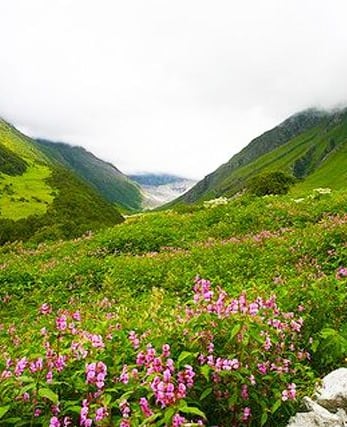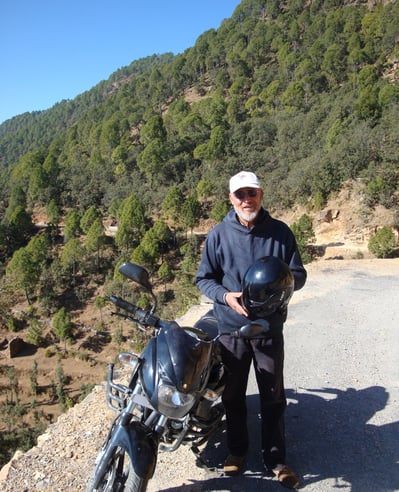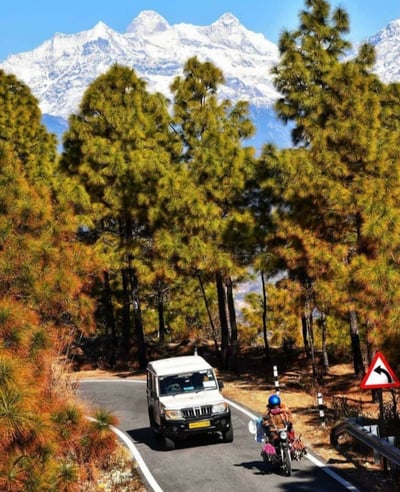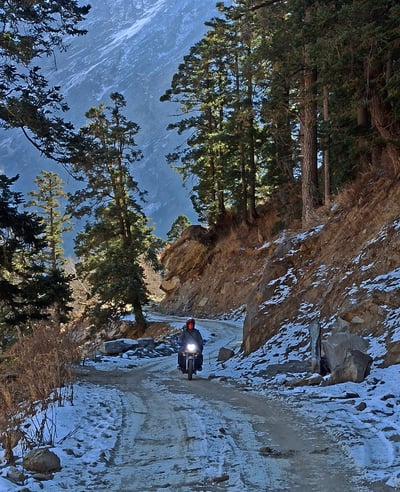Adi kailash yatra is now live - Advance bookings open
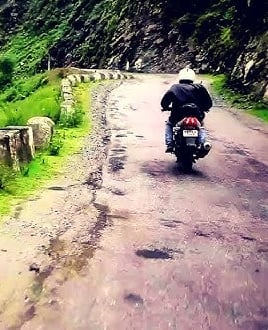

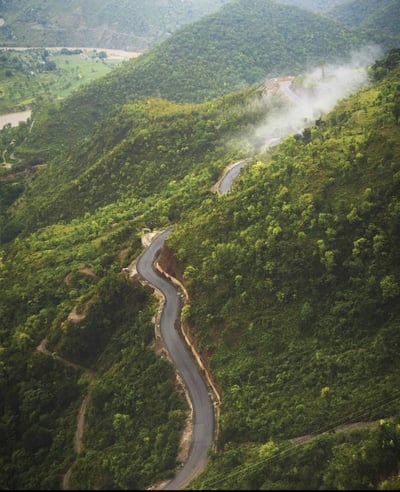



Terrain and Landscape:
The terrain includes hilly roads, river valleys, and lush green landscapes. The landscape features the Beas River, Parvati Valley, and pine forests. Key highlights include the scenic views from Swarghat, the Beas River in Mandi, and the beautiful Parvati Valley leading to Kasol.
Best Time to Ride:
March to June and September to November. The weather is pleasant and ideal for riding during these periods. Avoid the monsoon season (July-August) due to heavy rains and potential landslides, and the winter months (December-February) due to snow.
Terrain and Landscape:
The route from Haldwani to Pithoragarh features winding hilly roads, dense forests, and serene river valleys. The journey takes you through the Kumaon region, offering panoramic views of terraced fields, pine and oak forests, and the scenic Saryu and Kali rivers. Key highlights include the beautiful landscapes of Almora and the picturesque vistas near Lohaghat as you approach Pithoragarh.
Best Time to Ride:
March to June and September to November are the ideal times for this journey. The weather during these months is pleasant and perfect for riding, with clear skies and comfortable temperatures. Avoid traveling during the monsoon season (July-August) due to heavy rains and landslides, and during winter (December-February) as the higher altitudes near Pithoragarh may experience snow and icy roads.
Terrain and Landscape:
The route from Dehradun to Dhanaulti features smooth yet winding mountain roads, passing through dense forests of deodar, rhododendron, and oak. The journey offers spectacular views of the lower Himalayan ranges, misty valleys, and quaint villages. Key highlights include the Mussoorie-Dhanaulti road, lush green surroundings, and glimpses of snow-capped peaks during clear weather.
Best Time to Ride:
The best time to ride is from March to June and September to November. During these months, the weather is pleasant and perfect for outdoor activities, with clear skies and mild temperatures. Avoid the monsoon season (July-August) due to slippery roads and landslide risks, and exercise caution in winter (December-February) as Dhanaulti often experiences snowfall, which can make roads icy and challenging.
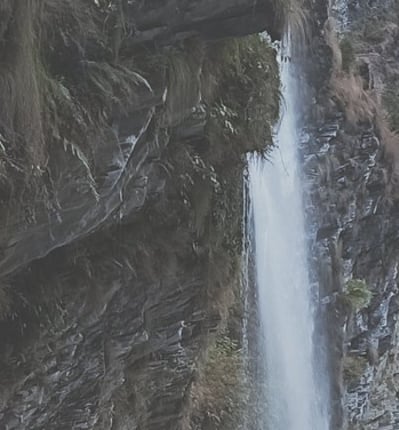

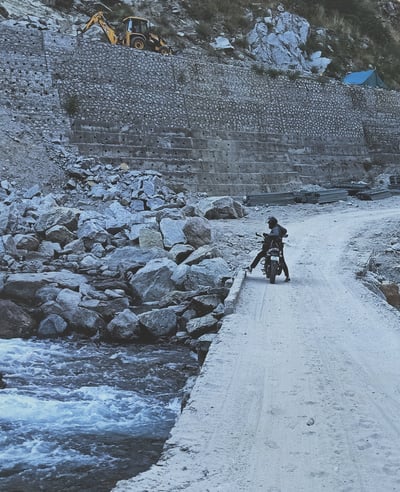

Terrain and Landscape:
The route from Pithoragarh to Munsiyari is a mesmerizing journey through steep mountain roads, dense forests, and serene river valleys. The landscape transitions from terraced fields to the rugged beauty of the Kumaon Himalayas, with breathtaking views of the Panchachuli peaks. Key highlights include the Mahakali River at Jauljibi, the winding roads of Thal, and the spectacular vistas as you approach Munsiyari.
Best Time to Ride:
The ideal time for this journey is between March to June and September to November. During these periods, the weather is pleasant, with clear skies offering unhindered views of the snow-capped mountains. Avoid traveling during the monsoon season (July-August) due to heavy rains and landslide risks, and exercise caution in winter (December-February) as Munsiyari often experiences heavy snowfall, which can make the roads treacherous.
Terrain and Landscape:
The journey from Dharchula to Dugtu Village takes you through rugged mountain roads, dense forests, and serene river valleys. The route lies in the Darma Valley of the Kumaon Himalayas and offers panoramic views of the mighty Panchachuli peaks. Key highlights include crossing the Kali River, quaint villages like Sobla, and driving through the pristine Darma Valley to reach Dugtu.
Best Time to Visit:
April to June and September to November are the best times for this journey. During these months, the weather is favorable, with clear skies and pleasant temperatures, perfect for trekking and enjoying the Himalayan views. The monsoon season (July-August) should be avoided due to landslides and swollen rivers, and winters (December-March) bring heavy snow, making access to Dugtu challenging.
Terrain and Landscape:
The route from Dharchula to Adi Kailash (via the Jolingkong Base Camp) takes you through breathtaking Himalayan terrain, featuring steep mountain roads, river crossings, and dense forests. The drive passes through scenic villages like Tawaghat, Gunji, and Nabi, offering stunning views of snow-capped peaks, meandering rivers, and deep valleys. The final stretch to Adi Kailash includes rugged dirt tracks and narrow roads, which require skilled driving and a sturdy vehicle, preferably a 4x4.
Best Time to Drive:
The best time to undertake this journey is between May and June or September to October. During these months, the weather is stable, with clear skies and moderate temperatures, making the roads safer and the mountain views stunning.
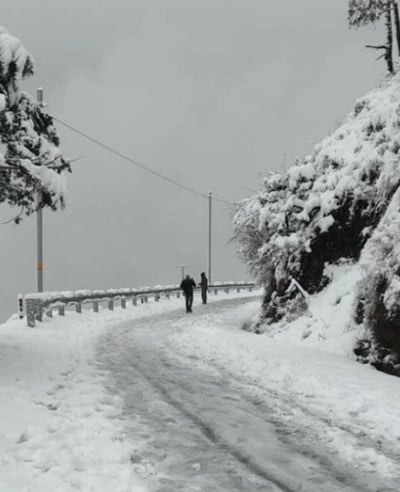

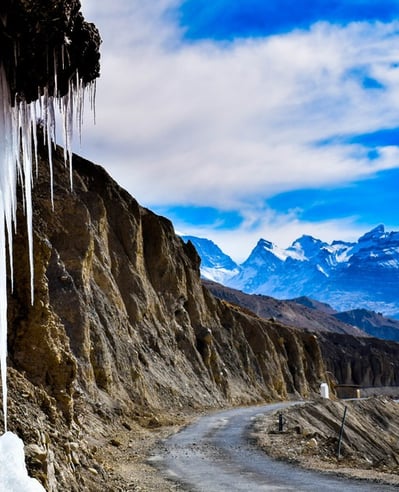

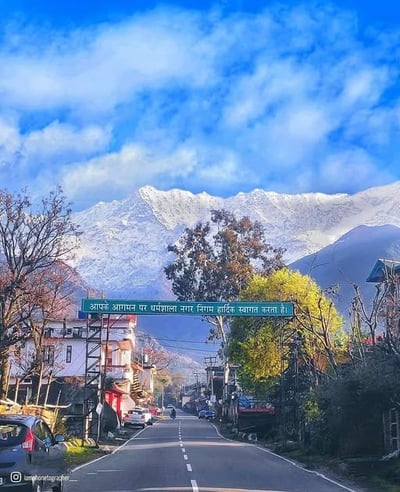

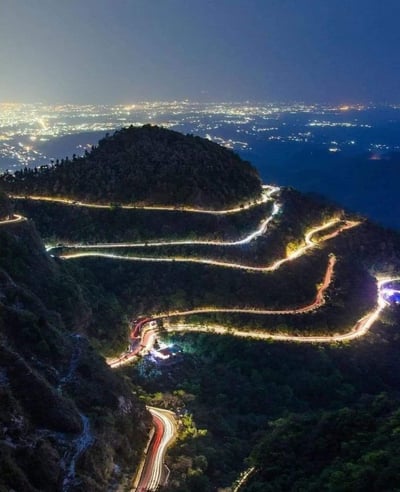

Terrain and Landscape:
The terrain includes lush green valleys, apple orchards, high mountain passes, rocky landscapes, and remote villages. Key highlights include Narkanda, Sangla Valley, Kalpa, Nako Lake, and the ancient monasteries of Tabo and Dhankar.
Best Time to Ride:
May to October. Roads are generally open and accessible during this period, with moderate temperatures and clear weather. Avoid the monsoon season (July-August) due to landslides.
Terrain and Landscape:
The terrain varies from flat plains around Chandigarh to hilly terrain and lush greenery as you approach Dharamshala. Highlights include winding roads, river crossings, and panoramic views of the Dhauladhar Range.
Best Time to Ride:
March to June and September to November. Avoid the monsoon season (July-August) due to heavy rainfall.
Terrain and Landscape:
The terrain starts from plains near Dehradun, ascends through hilly regions of Garhwal, and culminates in the mountainous landscapes of Auli.
Best Time to Ride:
April to June and September to November are ideal. Avoid monsoon (July to August) due to landslides.
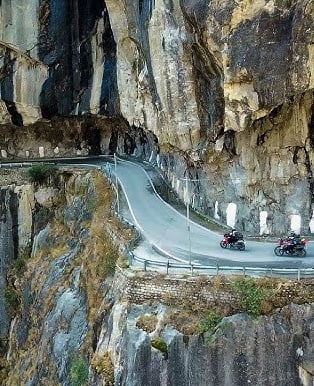

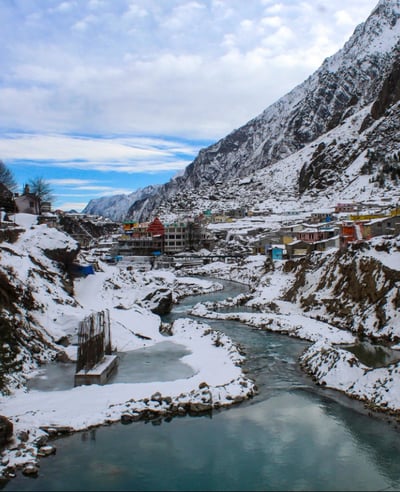

Terrain and Landscape:
The terrain along this route is diverse and stunning. Starting from the bustling town of Shimla, the road winds through lush green forests of pine and cedar as you ascend to Narkanda. Here, you'll be greeted with panoramic views of snow-capped peaks and apple orchards. The descent to Rampur offers picturesque views of the Sutlej River. As you approach Kinnaur, the landscape becomes more dramatic, with deep gorges, towering cliffs, and fastflowing rivers. The Sangla Valley is known for its lush greenery, beautiful meadows, and traditional wooden houses, while the journey to Reckong Peo and Kalpa offers spectacular views of the Kinner Kailash range. The mix of lush valleys, high-altitude deserts, and dramatic mountain scenery makes this ride a visual feast.
Best Time to Ride:
The best time to undertake this journey is from April to June and September to October. During these months, the weather is pleasant, and the roads are generally in good condition. April to June is the spring and early summer season, offering blooming flora and clear skies. September to October provides cool, crisp weather and vibrant autumn colors, making it an ideal time for riding. Avoid the monsoon season (July and August) due to the risk of landslides and slippery roads, and the winter months (November to March) when snow and ice can make the roads hazardous.
Terrain and Landscape:
The terrain along this route is diverse and captivating. Starting from the lush green foothills of Rishikesh, the road winds along the Ganges River, offering stunning views of the river and the surrounding hills. As you ascend towards Devprayag, where the Alaknanda and Bhagirathi rivers merge to form the Ganges, the terrain becomes more rugged with steep slopes and deep valleys. The journey through Srinagar, Rudraprayag, and Karnaprayag offers a mix of river valleys, terraced fields, and dense forests. As you approach Joshimath and Badrinath, the landscape transforms into highaltitude terrain with snow-capped peaks, alpine meadows, and glacial rivers. The route is dotted with numerous temples, shrines, and ashrams, adding to its spiritual and cultural richness.
Best Time to Visit:
The best time to undertake this journey is from May to October. During these months, the weather is relatively stable, and the roads are generally open and accessible. May to June offers mild temperatures and clear skies, making it an ideal time for riding. The monsoon season (July to September) brings heavy rainfall and the risk of landslides, so it is best avoided. September to October provides cool, crisp weather and vibrant autumn colors, making it another excellent time for this ride. Avoid the winter months (November to April) when heavy snowfall can close the roads and make travel hazardous.
Terrain and Landscape:
The terrain along this route varies from the flat plains around Haridwar to gradually ascending hills as you approach Mussoorie. Starting from the bustling cityscape of Haridwar, the road follows the meandering Ganges River and then ascends through forested hills and valleys. As you reach Rishikesh and Narendra Nagar, the landscape offers glimpses of the river and terraced fields against a backdrop of distant mountains. The final stretch to Mussoorie is characterized by steep climbs, offering panoramic views of the Shivalik range and the Doon Valley below. Mussoorie itself is nestled amidst pinecovered slopes, offering breathtaking vistas of the Himalayan peaks on clear days.
Best Time to Drive:
The best time to undertake this journey is from March to June and September to November. During these months, the weather is pleasant with mild temperatures, clear skies, and blooming flora. March to June is ideal for experiencing the vibrant greenery and comfortable riding conditions. September to November offers crisp autumn weather and stunning views of the changing foliage, making it another excellent time for this ride. Avoid the monsoon season (July and August) due to heavy rainfall and the winter months (December to February) when temperatures can drop sharply and roads may be affected by snowfall.
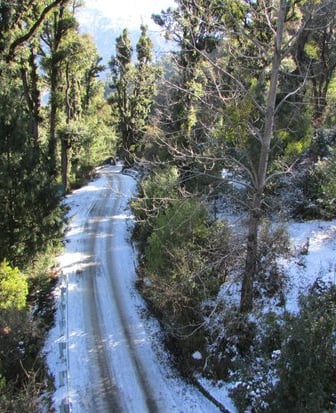

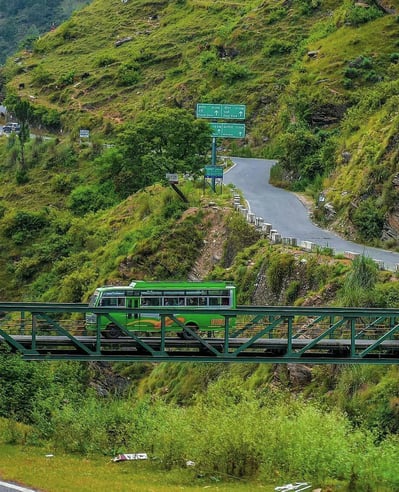



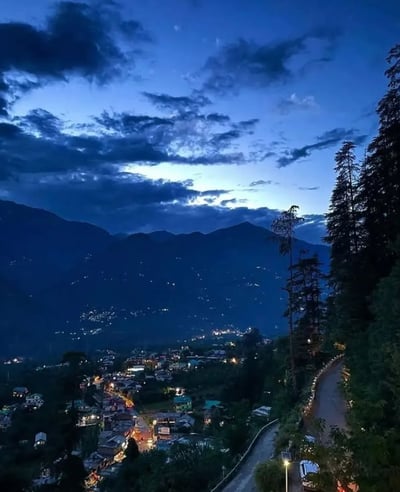

Terrain and Landscape:
The terrain along this route is diverse and scenic. Starting from Nainital, nestled amidst hills and surrounded by the Naini Lake, the road initially winds through dense forests and small villages. As you proceed towards Bhowali and Khairna, the landscape opens up to terraced fields, orchards, and panoramic views of the surrounding hills. The final stretch to Almora is characterized by steep ascents with vistas of the Himalayan peaks on clear days. Almora itself is perched on a ridge, offering stunning views of the valley below and the snow-capped mountains in the distance.
Best Time to Ride:
The best time to undertake this journey is from March to June and September to November. During these months, the weather is pleasant with mild temperatures, clear skies, and blooming flora. March to June is ideal for experiencing the vibrant greenery and comfortable riding conditions. September to November offers crisp autumn weather and stunning views of the changing foliage, making it another excellent time for this ride. Avoid the monsoon season (July and August) due to heavy rainfall and the winter months (December to February) when temperatures can drop sharply and roads may be affected by snowfall.
Terrain and Landscape:
The terrain along this route is diverse and picturesque. Starting from Lansdowne, perched at an altitude of around 1,700 meters, riders descend through pine and oak forests with panoramic views of the Garhwal hills. The road to Kotdwar winds down the slopes, offering glimpses of terraced fields and river valleys. From Kotdwar to Dugadda, the terrain becomes more rugged, with dense forests and occasional streams crossing the path. The final stretch to Jim Corbett National Park passes through lush greenery and open plains, with the possibility of spotting wildlife like deer, elephants, and various bird species.
Best Time to Ride:
The best time to undertake this journey is from November to June. During these months, the weather is pleasant with mild temperatures and clear skies. November to February offers cool and comfortable riding conditions, while March to June provides warm weather ideal for exploring the natural beauty and wildlife of the region. Avoid the monsoon season (July-September) due to heavy rainfall, which can lead to landslides and slippery roads. Additionally, some parts of Jim Corbett National Park may be closed during the monsoon for safety reasons.
Terrain and Landscape:
The terrain along this route is a mix of gently rolling hills, dense forests, and open meadows. The ride starts with a descent from Dalhousie, offering panoramic views of the surrounding valleys and mountains. As you approach Khajjiar, the landscape changes to lush green meadows surrounded by dense deodar and pine forests. Key highlights include the breathtaking views from various vantage points along the road, the serene Khajjiar Lake, and the expansive Khajjiar Meadow, which is perfect for a leisurely stroll or a picnic. The route is dotted with small villages and hamlets, adding to its charm and providing opportunities to interact with the friendly locals.
Best Time to Ride:
The best time to undertake this ride is from March to June and September to November. During these months, the weather is pleasant and the roads are in good condition. March to June is the spring and early summer season, offering mild temperatures and blooming flora. September to November brings cool, crisp weather and clear skies, making it ideal for riding. Avoid the monsoon season (July and August) due to the risk of landslides and slippery roads, and the winter months (December to February) when snow and ice can make the roads hazardous.
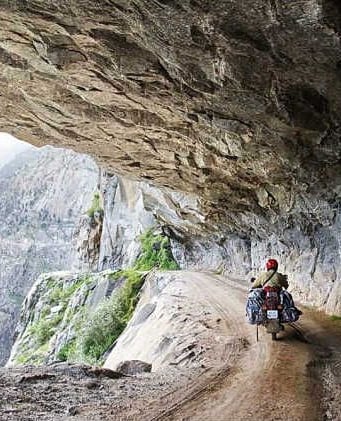

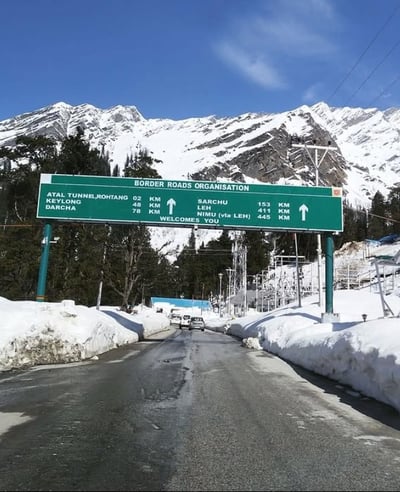

Terrain and Landscape:
The terrain along this route is diverse and dramatic. Starting from the lush green valleys of Manali, the journey ascends through dense forests and alpine meadows towards the high-altitude Rohtang Pass. The pass itself offers stunning views of snowcapped peaks and glaciers. Beyond Rohtang Pass, the landscape transitions into a more arid and rugged terrain with steep cliffs, rocky outcrops, and the winding Chandra River. As you approach Keylong, the terrain becomes more hospitable, with terraced fields and small villages nestled in the valleys. The route is visually spectacular, offering panoramic views of the Himalayan ranges and deep gorges.
Best Time to Ride:
The best time to undertake this journey is from June to September when the weather is relatively mild and the roads are accessible. During these months, temperatures range from 10°C to 25°C, and the skies are generally clear. The monsoon season (July to August) can bring heavy rainfall, which may cause landslides and roadblocks, so it’s essential to check the weather forecast before starting your journey. The winter months (October to May) bring heavy snowfall, making the route impassable. The summer months offer the best opportunity to explore Keylong and enjoy the stunning mountain scenery.
Terrain and Landscape:
The terrain along this route is varied and picturesque. Starting from the urban environment of Shimla, the journey transitions into more rural settings characterized by dense forests, small towns, and the Beas River valley. The landscape is dotted with traditional Himachali houses, terraced fields, and lush greenery. As you approach Kullu, the valley opens up with expansive views of the river and surrounding mountains. The final stretch to Manali offers stunning vistas of snow-capped peaks, apple orchards, and pine forests. The route is visually appealing, with clear skies and expansive horizons, providing a peaceful and scenic ride.
Best Time to Visit:
The best time to undertake this journey is from April to June and September to November when the weather is mild and the roads are accessible. During these months, temperatures range from 15°C to 25°C, and the skies are generally clear. The monsoon season (July to August) brings heavy rainfall, which can make the roads slippery and the ride challenging. The winter months (December to March) bring snowfall, especially around Manali, making the route difficult to navigate without proper gear and experience. The spring and autumn months offer the best opportunity to explore Manali and enjoy the natural beauty of the region.
Terrain and Landscape:
The terrain along this route is varied and picturesque. Starting from the urban environment of Kullu, the journey transitions into more rural settings characterized by dense forests, small towns, and the Beas River valley. The landscape is dotted with traditional Himachali houses, terraced fields, and lush greenery. As you approach Naggar, the valley opens up with expansive views of the river and surrounding mountains. The final stretch to Naggar offers stunning vistas of snow-capped peaks, apple orchards, and pine forests. The route is visually appealing, with clear skies and expansive horizons, providing a peaceful and scenic ride.
Best Time to Drive:
The best time to undertake this journey is from April to June and September to November when the weather is mild and the roads are accessible. During these months, temperatures range from 15°C to 25°C, and the skies are generally clear. The monsoon season (July to August) brings heavy rainfall, which can make the roads slippery and the ride challenging. The winter months (December to March) bring snowfall, especially around Naggar, making the route difficult to navigate without proper gear and experience. The spring and autumn months offer the best opportunity to explore Naggar and enjoy the natural beauty of the region.
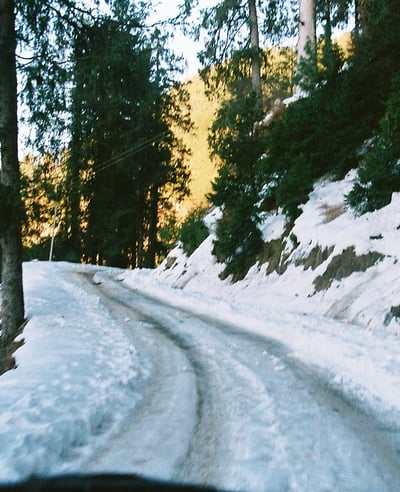

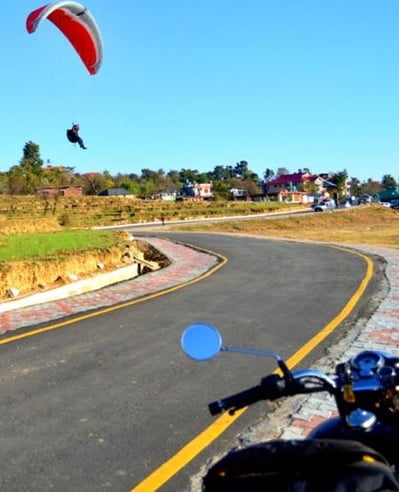

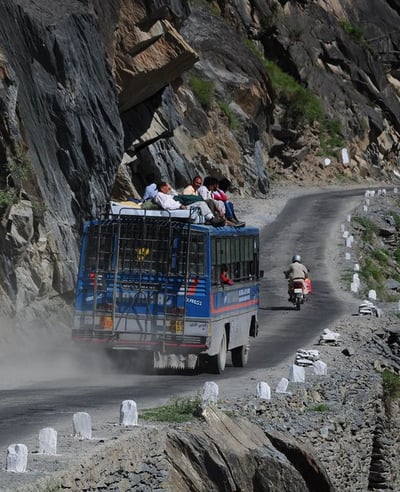

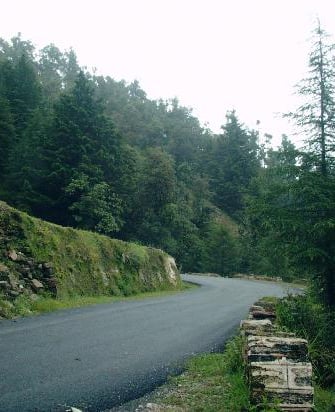

Terrain and Landscape:
The terrain along this route is varied and picturesque. Starting from the urban environment of Dharamshala, the journey transitions into more rural settings characterized by dense forests, small towns, and tea gardens. The landscape is dotted with traditional Himachali houses, terraced fields, and lush greenery. As you approach Bir Billing, the terrain becomes more hilly and rugged with winding roads offering panoramic views of the surrounding mountains and valleys. The route is visually appealing, with clear skies and expansive horizons, providing a peaceful and scenic ride.
Best Time to Ride:
The best time to undertake this journey is from March to June and September to November when the weather is mild and the skies are clear. During these months, temperatures range from 10°C to 25°C, making for comfortable riding conditions. The monsoon season (July to August) brings heavy rainfall, which can make the roads slippery and the ride challenging. The winter months (December to February) bring cold temperatures and occasional snowfall, especially around Bir Billing, making the route more difficult to navigate. The spring and autumn months offer the best opportunity to explore Bir Billing and enjoy the natural beauty and adventure sports of the region.
Terrain and Landscape:
The terrain along this route is varied and picturesque. Starting from the lush, pine-covered hills of Dalhousie, the journey transitions into more open valleys characterized by terraced fields, small villages, and dense forests. The landscape is dotted with traditional Himachali houses, lush greenery, and occasional patches of wildflowers. As you approach Chamba, the valley opens up with expansive views of the Ravi River and surrounding mountains. The final stretch to Chamba offers stunning vistas of snowcapped peaks, apple orchards, and verdant forests. The route is visually appealing, with clear skies and expansive horizons, providing a peaceful and scenic ride.
Best Time to Ride:
The best time to undertake this journey is from March to June and September to November when the weather is mild and the skies are clear. During these months, temperatures range from 15°C to 25°C, making for comfortable riding conditions. The monsoon season (July to August) brings heavy rainfall, which can make the roads slippery and the ride challenging. The winter months (December to February) bring cold temperatures and occasional snowfall, especially around Dalhousie, making the route more difficult to navigate. The spring and autumn months offer the best opportunity to explore Chamba and enjoy the natural beauty of the region.
Terrain and Landscape:
The terrain along this route is diverse and stunning. Starting from the urban environment of Mandi, the journey transitions into more rural settings characterized by dense forests, small villages, and terraced fields. The landscape is dotted with traditional Himachali houses, lush greenery, and occasional patches of wildflowers. As you ascend towards Prashar Lake, the terrain becomes more hilly and rugged, offering panoramic views of the surrounding mountains and valleys. The final stretch to Prashar Lake provides stunning vistas of snowcapped peaks and the serene lake itself, surrounded by alpine meadows and forests. The route is visually captivating, with clear skies and expansive horizons, providing a peaceful and scenic ride.
Best Time to Ride:
The best time to undertake this journey is from April to June and September to November when the weather is mild and the skies are clear. During these months, temperatures range from 10°C to 25°C, making for comfortable riding conditions. The monsoon season (July to August) brings heavy rainfall, which can make the roads slippery and the ride challenging. The winter months (December to March) bring cold temperatures and heavy snowfall, especially around Prashar Lake, making the route more difficult to navigate. The spring and autumn months offer the best opportunity to explore Prashar Lake and enjoy the natural beauty of the region.
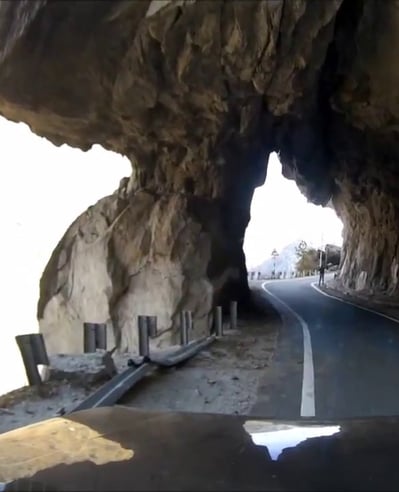

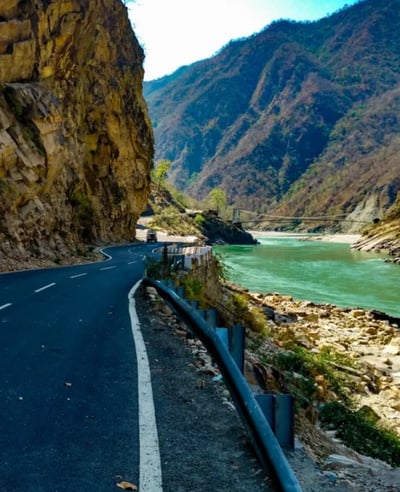

Terrain and Landscape:
The terrain on this route is predominantly mountainous, with steep ascents and descents. You'll ride through dense pine forests, cross rivers, and pass by terraced fields and apple orchards. The higher you go, the more dramatic the landscape becomes, with towering snow-capped peaks and deep valleys. The views of the Kinner Kailash range are particularly stunning, offering a spectacular backdrop for the ride.
Best Time to Ride:
The best time to undertake this ride is between April and October. During these months, the weather is relatively mild, and the roads are more accessible. The spring and summer months (April to June) are ideal for clear skies and blooming flora, while the autumn months (September to October) offer crisp air and vibrant fall colors. Avoid the monsoon season (July to August) due to the risk of landslides and slippery roads.
Terrain and Landscape:
The terrain along this route is mostly flat with gentle slopes as you approach Rishikesh. Starting from the urban environment of Haridwar, the journey transitions into more scenic settings characterized by the flowing Ganges River, lush greenery, and distant views of the Himalayan foothills. The landscape includes stretches of forests, small villages, and agricultural fields. As you get closer to Rishikesh, the terrain becomes slightly hilly, offering beautiful vistas of the river and surrounding areas. The route is visually appealing, providing a peaceful and scenic ride.
Best Time to Visit:
The best time to undertake this journey is from October to March when the weather is cool and pleasant, making for comfortable riding conditions. During these months, temperatures range from 10°C to 25°C, and the skies are generally clear. The monsoon season (July to September) brings heavy rainfall, which can make the roads slippery and the ride challenging. The summer months (April to June) can be hot, but mornings and evenings are still enjoyable for riding. The winter months offer the best opportunity to explore Haridwar and Rishikesh and enjoy the natural beauty of the region.
Terrain and Landscape:
The terrain along this route is varied and picturesque. Starting from the urban environment of Nainital, the journey transitions into more rural settings characterized by dense forests, small villages, and terraced fields. The landscape is dotted with traditional Kumaoni houses, lush greenery, and occasional patches of wildflowers. As you ascend towards Mukteshwar, the terrain becomes more hilly and rugged, offering stunning views of the surrounding mountains and valleys. The final stretch to Mukteshwar provides breathtaking vistas of the Himalayas, apple orchards, and pine forests. The route is visually captivating, with clear skies and expansive horizons, providing a peaceful and scenic ride.
Best Time to Drive:
The best time to undertake this journey is from March to June and September to November when the weather is mild and the skies are clear. During these months, temperatures range from 10°C to 25°C, making for comfortable riding conditions. The monsoon season (July to August) brings heavy rainfall, which can make the roads slippery and prone to landslides. The winter months (December to February) bring cold temperatures and occasional snowfall, especially around Mukteshwar, making the route more difficult to navigate. The spring and autumn months offer the best opportunity to explore Mukteshwar and enjoy the natural beauty of the region.

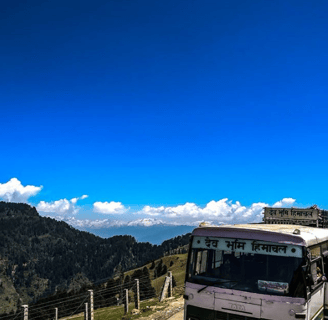
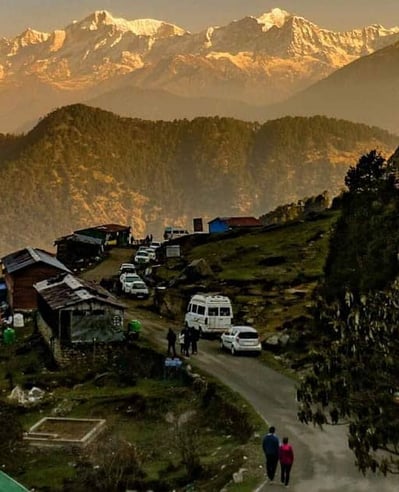

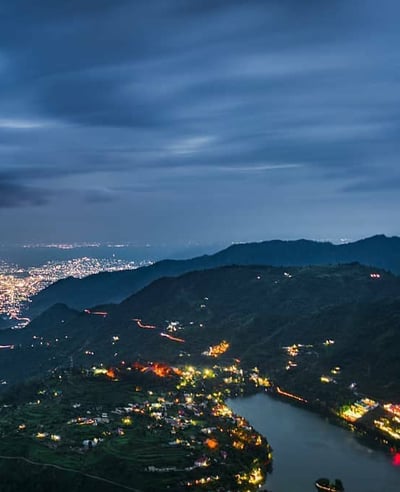

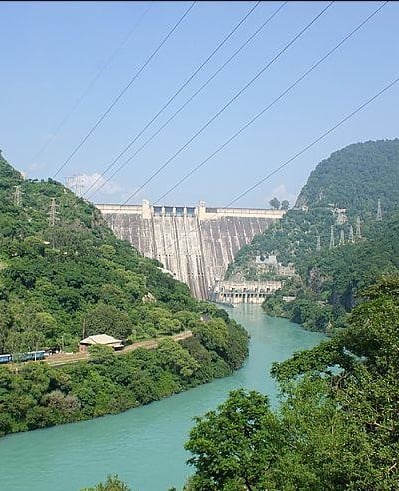

Terrain and Landscape:
The terrain along this route is diverse and breathtaking. Starting from the bustling environment of Rishikesh, the journey transitions into more serene settings characterized by the flowing Ganges River, lush greenery, and distant views of the Himalayan foothills. As you ascend towards Chopta, the terrain becomes more hilly and rugged, offering stunning views of the surrounding mountains, valleys, and rivers. The landscape includes stretches of forests, small villages, and terraced fields. The final stretch to Chopta provides panoramic vistas of the snow-capped peaks, alpine meadows, and dense forests. The route is visually captivating, with clear skies and expansive horizons, providing a peaceful and scenic ride.
Best Time to Ride:
The best time to undertake this journey is from April to June and September to November when the weather is mild and the skies are clear. During these months, temperatures range from 10°C to 25°C, making for comfortable riding conditions. The monsoon season (July to August) brings heavy rainfall, which can make the roads slippery and prone to landslides. The winter months (December to March) bring cold temperatures and heavy snowfall, especially around Chopta, making the route more difficult to navigate. The spring and autumn months offer the best opportunity to explore Chopta and enjoy the natural beauty of the region.
Terrain and Landscape:
The terrain along this route is varied and stunning. Starting from the urban environment of Haldwani, the journey transitions into more serene settings characterized by dense forests, small villages, and terraced fields. The landscape is dotted with traditional Kumaoni houses, lush greenery, and occasional patches of wildflowers. As you ascend towards Bhimtal, the terrain becomes more hilly and rugged, offering stunning views of the surrounding mountains and valleys. The final stretch to Bhimtal provides breathtaking vistas of the lake, pine forests, and the picturesque town. The route is visually captivating, with clear skies and expansive horizons, providing a peaceful and scenic ride.
Best Time to Ride:
The best time to undertake this journey is from March to June and September to November when the weather is mild and the skies are clear. During these months, temperatures range from 10°C to 25°C, making for comfortable riding conditions. The monsoon season (July to August) brings heavy rainfall, which can make the roads slippery and prone to landslides. The winter months (December to February) bring cold temperatures and occasional snowfall, especially around Bhimtal, making the route more difficult to navigate. The spring and autumn months offer the best opportunity to explore Bhimtal and enjoy the natural beauty of the region.
Terrain and Landscape:
The terrain along this route is diverse and breathtaking. Starting from the urban environment of Joshimath, the journey transitions into more serene settings characterized by dense forests, small villages, and the Alaknanda River. The landscape is dotted with traditional Garhwali houses, terraced fields, and lush greenery. As you ascend towards Govindghat, the terrain becomes more hilly and rugged, offering stunning views of the surrounding mountains and valleys. The trek from Govindghat to Ghangaria and then to the Valley of Flowers provides breathtaking vistas of snow-capped peaks, alpine meadows, and a diverse array of flora and fauna. The route is visually captivating, with clear skies and expansive horizons, providing a peaceful and scenic experience.
Best Time to Ride:
The best time to undertake this journey is from June to September when the Valley of Flowers is in full bloom, making for a spectacular and colorful display. During these months, temperatures range from 15°C to 25°C, making for comfortable trekking conditions. The monsoon season (July to August) brings heavy rainfall, which can make the roads slippery and prone to landslides, but it is also the best time to see the valley in its full glory. The trek is generally not recommended during the winter months (October to May) due to heavy snowfall and harsh weather conditions, which make the route inaccessible.
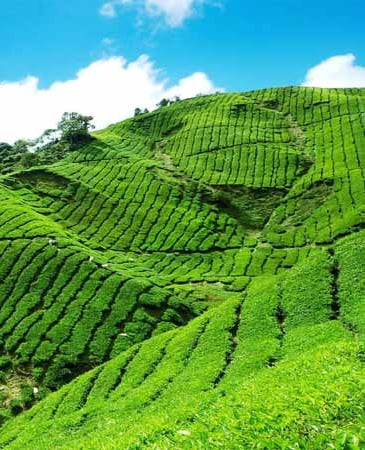

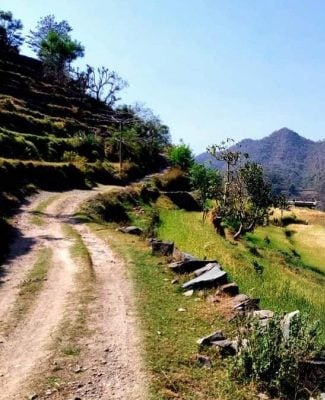

Terrain and Landscape:
The terrain along this route is varied and stunning. Starting from the lush, green environment of Ranikhet, the journey transitions into more serene settings characterized by dense forests, small villages, and terraced fields. The landscape is dotted with traditional Kumaoni houses, lush greenery, and occasional patches of wildflowers. As you ascend towards Kausani, the terrain becomes more hilly and rugged, offering stunning views of the surrounding mountains and valleys. The final stretch to Kausani provides breathtaking vistas of the Himalayan peaks, pine forests, and the picturesque town. The route is visually captivating, with clear skies and expansive horizons, providing a peaceful and scenic ride.
Best Time to Ride:
The best time to undertake this journey is from March to June and September to November when the weather is mild and the skies are clear. During these months, temperatures range from 10°C to 25°C, making for comfortable riding conditions. The monsoon season (July to August) brings heavy rainfall, which can make the roads slippery and prone to landslides. The winter months (December to February) bring cold temperatures and occasional snowfall, especially around Kausani, making the route more difficult to navigate. The spring and autumn months offer the best opportunity to explore Kausani and enjoy the natural beauty of the region.
Terrain and Landscape:
The terrain from Chandigarh to Morni Hills transitions from the urban landscape of Chandigarh to the scenic, winding roads of the hills. The route offers beautiful views of the Shivalik range, dense forests, and verdant valleys. As you climb higher, the temperature drops slightly, and the air becomes fresher. You will pass through small villages and see terraced fields and forests. The landscape is dotted with pine trees and offers stunning views of the surrounding hills and valleys, making it a visually delightful ride.
Best Time to Visit:
The best time to visit Morni Hills is from September to March. During this period, the weather is pleasant, with temperatures ranging from 10°C to 25°C. The monsoon season (July to August) brings moderate to heavy rainfall, which can make the roads slippery and less safe for riding. Summers (April to June) can be warm, but the higher altitude of Morni Hills provides some relief from the heat compared to the plains. Winter months are ideal for riding as the weather is cool and crisp, perfect for exploring the hills.
Terrain and Landscape:
The terrain from Ropar to Nangal is predominantly flat, with gentle undulations as you move closer to the Shivalik foothills. The landscape is characterized by lush green fields, interspersed with patches of forest and small water bodies. You will pass through picturesque villages, offering a glimpse of rural Punjab's agrarian lifestyle. The ride becomes particularly scenic as you approach Nangal, with views of the Sutlej River and the surrounding hills.
Best Time to Drive:
The best time to undertake this ride is during the cooler months from October to March. During this period, the weather is pleasant, with temperatures ranging from 10°C to 25°C, making for a comfortable journey. The summer months from April to June can be extremely hot, with temperatures often exceeding 40°C, which can make riding uncomfortable and tiring. The monsoon season from July to September brings moderate to heavy rainfall, which can make the roads slippery but also enhances the natural beauty of the landscape.
